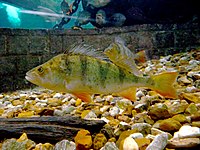
Photo from wikipedia
The pace-of-life syndrome (POLS) concept predicts that individuals with high baseline metabolic rates demonstrate high boldness, aggressiveness, and activity, especially in food acquisition, with associated relatively greater energy requirements. In… Click to show full abstract
The pace-of-life syndrome (POLS) concept predicts that individuals with high baseline metabolic rates demonstrate high boldness, aggressiveness, and activity, especially in food acquisition, with associated relatively greater energy requirements. In fishes, these behaviors may increase individual vulnerability to angling. To test the predictions of the POLS concept, we quantified individual standard metabolic rate (SMR) and boldness in both wild-caught and hatchery-reared Eurasian perch (Perca fluviatilis). We found both SMR and boldness to be repeatable traits but detected no correlation between them. Individual vulnerability to angling was assessed in the hatchery-reared perch, but we found no difference in boldness or SMR between vulnerable and nonvulnerable perch. Wild-caught perch were ice fished using either natural or artificial bait, and we observed no differences in boldness or SMR with respect to bait type or capture order. Our findings do not support the predictions of the POLS concept and, consistent with earlier studies in perch, suggest that angling may not drive selection against boldness in this species.
Journal Title: Physiological and Biochemical Zoology
Year Published: 2018
Link to full text (if available)
Share on Social Media: Sign Up to like & get
recommendations!